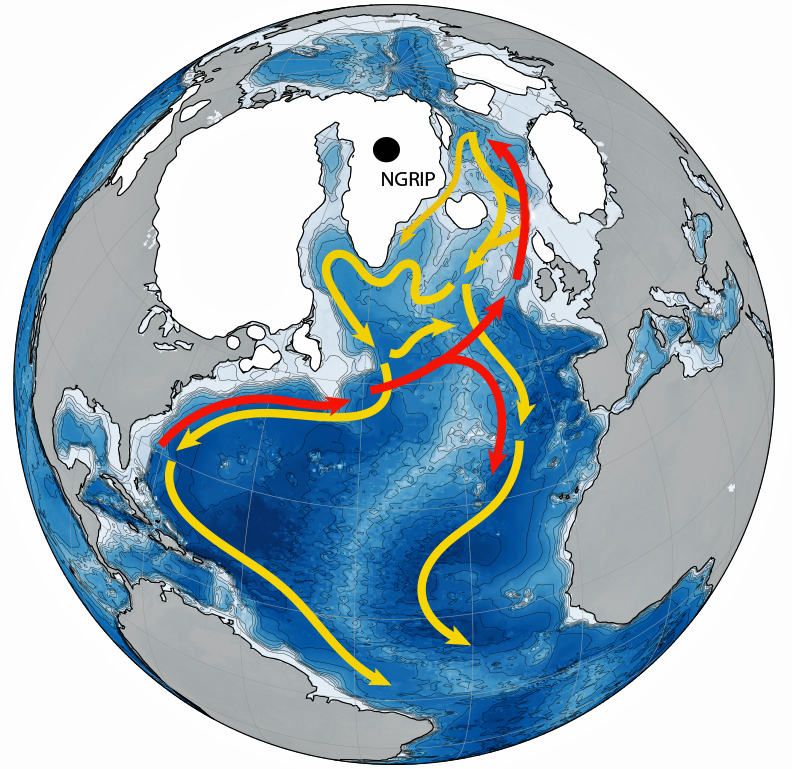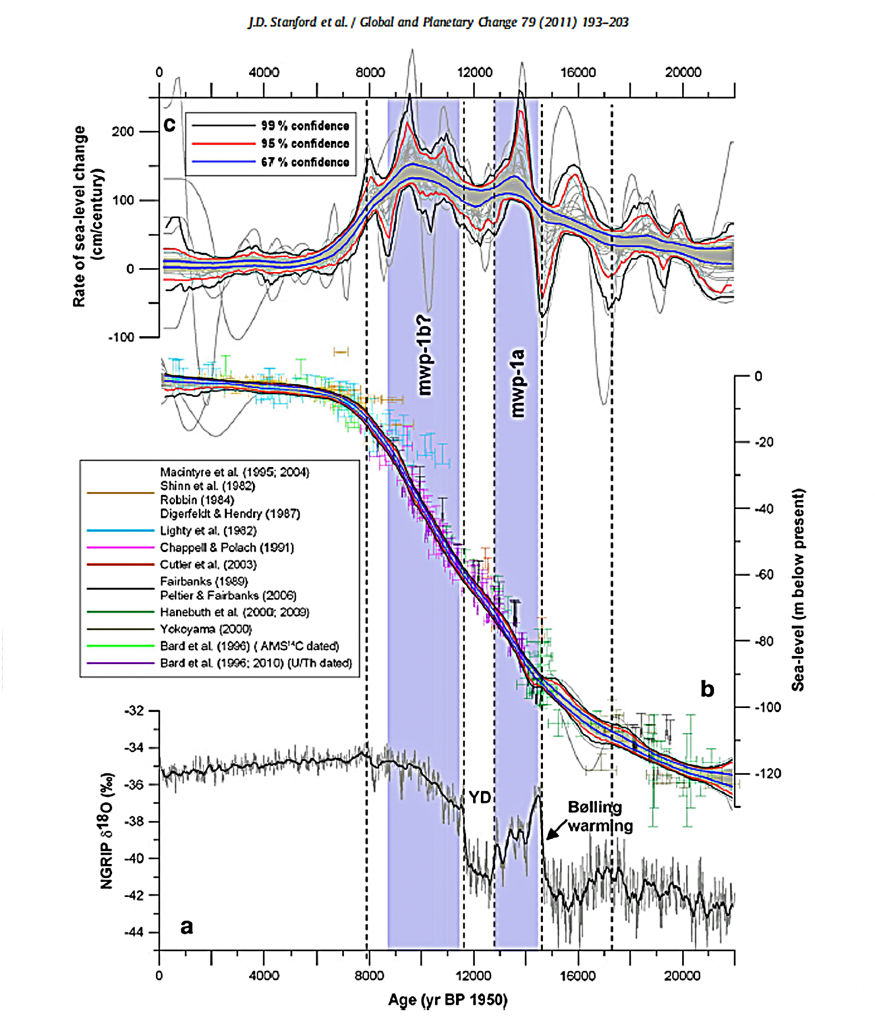Chapter 3 – Post Glacial Sea Levels
Book Extract…………………………….. The Post Glacial Flooding Hypothesis (Post Glacial Sea Levels)
If our ‘flooded Britain’ hypothesis is correct, we should be able to get verification via the empirical evidence of sea level changes to see if it has been constant over the last 12,500 years.
Most scientists and historians when talking about the end of the LGM, refer people to the phenomenon called the ‘Meltwater Pulses’ to prove that the exchange from frozen glaciers to today’s landscape was rapid.

| Figure 6.. Generalized sea level rise since the last ice age showing several meltwater pulses (MWP). MWP-1A0, c. 19,600-18,800 years ago; MWP-1A, 14,600 to 13,800 years ago; MWP-1B, 11,000-8,800 years ago; and MWP-1C, ~8,200-7,600 years ago. © Nasa model. |
The first significant increase in sea levels was (meltwater pulse 1Ao, or MWP 1Ao), 19,600-18,800 years ago, ocean levels climbed at least 10m within 800 years. However, not all sea-level proxies register this event.
A faster rise began 14,600 years ago during the comparatively mild Bølling-Allerød interstadial, which accelerated about 300 years later and peaked about 13,800 years ago (meltwater pulse 1A, or MWP 1A) (Stanford et al., 2011). Although it is a tremendous 20m surge in height, it should be recognised that this ‘pulse’ as only 16% of the total sea rise since the end of the LGM.
Computer models that “fingerprint” spatial patterns of sea-level rise attribute much of the meltwater to Antarctica. Different sources of ice melt leave geographically distinctive sea-level fingerprints because their ice unloading histories and the gravitational pull between shrinking ice masses and oceans vary.
On the other hand, geological data indicate significant deglaciation in Antarctica starting only toward the end of MWP 1A, which suggests that most of the meltwater originated from the breakup of Northern Hemisphere ice sheets.
During the Younger Dryas cold period, between 12,900 and 11,800 years ago, the encroaching oceans slowed their upward pace. A massive freshwater influx via the Mackenzie River into the Arctic Sea and ultimately the eastern North Atlantic may have triggered this cold episode. Once the warmth returned, rates of sea-level rise averaged 13 to 15 mm/yr during meltwater pulse 1B, 11,000-9,000 years ago, an event recorded in Barbados, but not in Pacific corals. This difference may arise from glacial isostatic or gravitational effects; alternatively, the increase at Barbados may have been overestimated.
Around 9,300 years ago, a glacial dam burst at the south-eastern end of Lake Superior, provoking pervasive Northern Hemisphere cooling, followed by a minor meltwater pulse about 9,000 years ago. However, meltwater pulse 1C (8,200-7,600 years ago) left traces at numerous locations in the United States, north-western Europe, and China.
Most glacial melting ended by about 7,000-6,000 years ago.
Because of slowly diminishing adjustments of Earth’s lithosphere to ice sheet removal, sea level falls near formerly ice-covered regions and rises along the margins of the vanished ice sheets. (Kemp et al., 2011).
This ‘conveyor belt’ carries warm water from the tropics (represented by red arrows) into the North Atlantic. There, the water cools and sinks before flowing back toward the south (yellow arrows). This pattern of circulation plays a vital role in regulating climate in the North Atlantic as well as the rest of the world. Image: (Muschitiello et al., 2019).

| Figure 7 – A simplified diagram of the Atlantic Meridional Overturning circulation |
What is of interest to our hypothesis is that the constant rise in sea levels is gradual if we takeout the meltwater pulses since the LGM ended.
Table 2 – Dates of meltwater Pulses
| Pulse | Date B.P. | Sea-Level Added | Rate (mm) per annum |
| MWP-1A0 | 19,500-19.000 | 10m | 2.00 |
| MWP-1A | 14,500 – 13,600 | 19m | 2.11 |
| MWP-1B | 11,500 – 11,200 | 13m | 4.33 |
| MWP-1C | 8,200 – 7,600 | 20m | 2.94 |
| Total | 59m (44%) |
Table 2 – lists the meltwater pulses and consequential sea level rises, taking away these pulses this leaves the remaining 76m (56%) of sea-level rises coming from a constant steady source over the last 15.6K years.
Meltwater Pulses are created by a sudden change in the climate which it is believed causes glaciation to shrink, as ice falls away from the glacier in large quantities. These events are probably more connected to sea ice cover that can melt rapidly rather than land-based ice which is usually slow to thaw.
These events would be in addition to the regular release of meltwater from the underground aquifers and groundwaters that flowed directly into the sea rising sea-levels by an average of 0.45mm per annum.
Figure 8 – shows the ‘Monte Carlo Experiment’ maths model that gives the results using 6m coral depth uncertainty.
- The GRIP ice core δ18O record on the GICC05 timescale (Andersen et al., 2006; Svensson et al., 2006; Rasmussen et al., 2006, 2008).
- The modelled sea-level probabilities are shown alongside the data used to construct the Monte Carlo simulations. The error bars shown represent the total uncertainties used in our reconstruction
- The first derivative of the reconstructed sea-level change. In panels b and c, 100 of the simulations are shown in light grey.
What is a Monte Carlo Simulation?
Monte Carlo simulation is a computerized mathematical technique that allows people to account for risk in quantitative analysis and decision making. The method is used by professionals in such widely disparate fields as finance, project management, energy, manufacturing, engineering, research and development, insurance, oil and gas, transportation, and the environment.

| Figure 8 – Illustration showing the meltwater pulses and constantly rising sea levels for thousands of years after the LGM ice has melted. |
Rivers and Streams
Using satellite and field work after an extreme melt event in Greenland, new research shows that melt-prone areas on the ice sheet develop a remarkably efficient drainage system of streams and rivers that carry meltwater into moulins (sinkholes) and ultimately the ocean.
The most significant single area of melting snow and ice in the world is the massive ice sheet that covers about 80 per cent of Greenland. This is recognised as the most significant potential contributor to rising sea levels due to glacial meltwater.
Until now, however, scientists’ attention has mostly focused on the ice sheet’s aquamarine lakes — bodies of meltwater that tend to drain abruptly — and on monster chunks of ice that slide into the ocean to become icebergs.
But a new UCLA-led study reveals a vast network of little-understood rivers and streams flowing on top of the ice sheet that could be responsible for at least as much, if not more, sea-level rises as the other two sources combined. The report measured the discharge across an area of 6,812 km2 of Greenland and found the glacier had created 523 high order stream/river channel networks.

| Figure 9 – UCLA led study reveals a vast network of little- understood rivers and streams flowing on top of the ice sheet. |
Within this area the researchers determined, the ice sheet drained at a rate of 55,000 to 61,000 cubic feet per second – a rate double the average of the Colorado River in the USA produces from less than a tenth of its watershed area.
Moreover, the researchers also found that there was 25% less discharged into the sea from these rivers than the model predicted, which indicated the balance was being absorbed into the groundwaters assisting their recharge (Smith et al., 2015)
If the same scenario were reflected in the ice sheet that covered Britain at the end of the LGM, then the U.K. ice sheet would have had 18,610 rivers formed on the ice sheet. Interestingly, we still have 1500 rivers and 15,000 streams in existence today still moving groundwater from land to the sea – some of which were created from the glaciation twenty thousand years ago.
• 6812 km2 / 523 observed rivers – gives us one river every 13.03 km2
• Britain is 242,495 km² / 13.03 km2 (the average area) per river would provide us with 18,610 ice rivers over Britain
These new observations show that when glaciers melt they not only recharge the groundwater levels and consequently the aquifers under its landmasses they also use the existing or create new rivers to connect the melting glaciers to the sea.
But what evidence is there that existing rivers were used to transport meltwater at the end of the ice age?
Further Reading
For information about British Prehistory, visit www.prehistoric-britain.co.uk for the most extensive archaeology blogs and investigations collection, including modern LiDAR reports. This site also includes extracts and articles from the Robert John Langdon Trilogy about Britain in the Prehistoric period, including titles such as The Stonehenge Enigma, Dawn of the Lost Civilisation and the ultimate proof of Post Glacial Flooding and the landscape we see today.
Robert John Langdon has also created a YouTube web channel with over 100 investigations and video documentaries to support his classic trilogy (Prehistoric Britain). He has also released a collection of strange coincidences that he calls ‘13 Things that Don’t Make Sense in History’ and his recent discovery of a lost Stone Avenue at Avebury in Wiltshire called ‘Silbury Avenue – the Lost Stone Avenue’.
Langdon has also produced a series of ‘shorts’, which are extracts from his main body of books:
For active discussions on the findings of the TRILOGY and recent LiDAR investigations that are published on our WEBSITE, you can join our and leave a message or join the debate on our Facebook Group.




